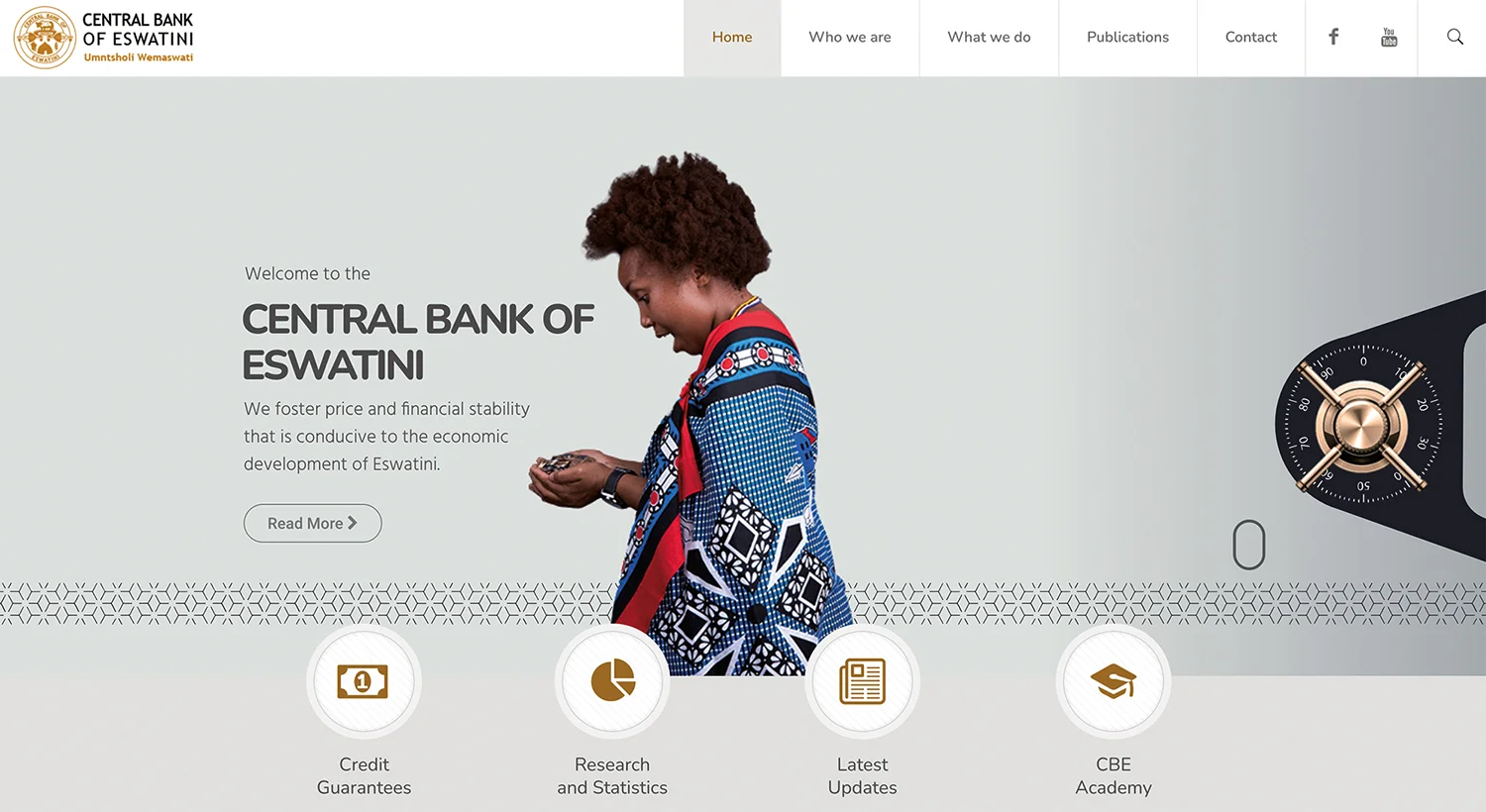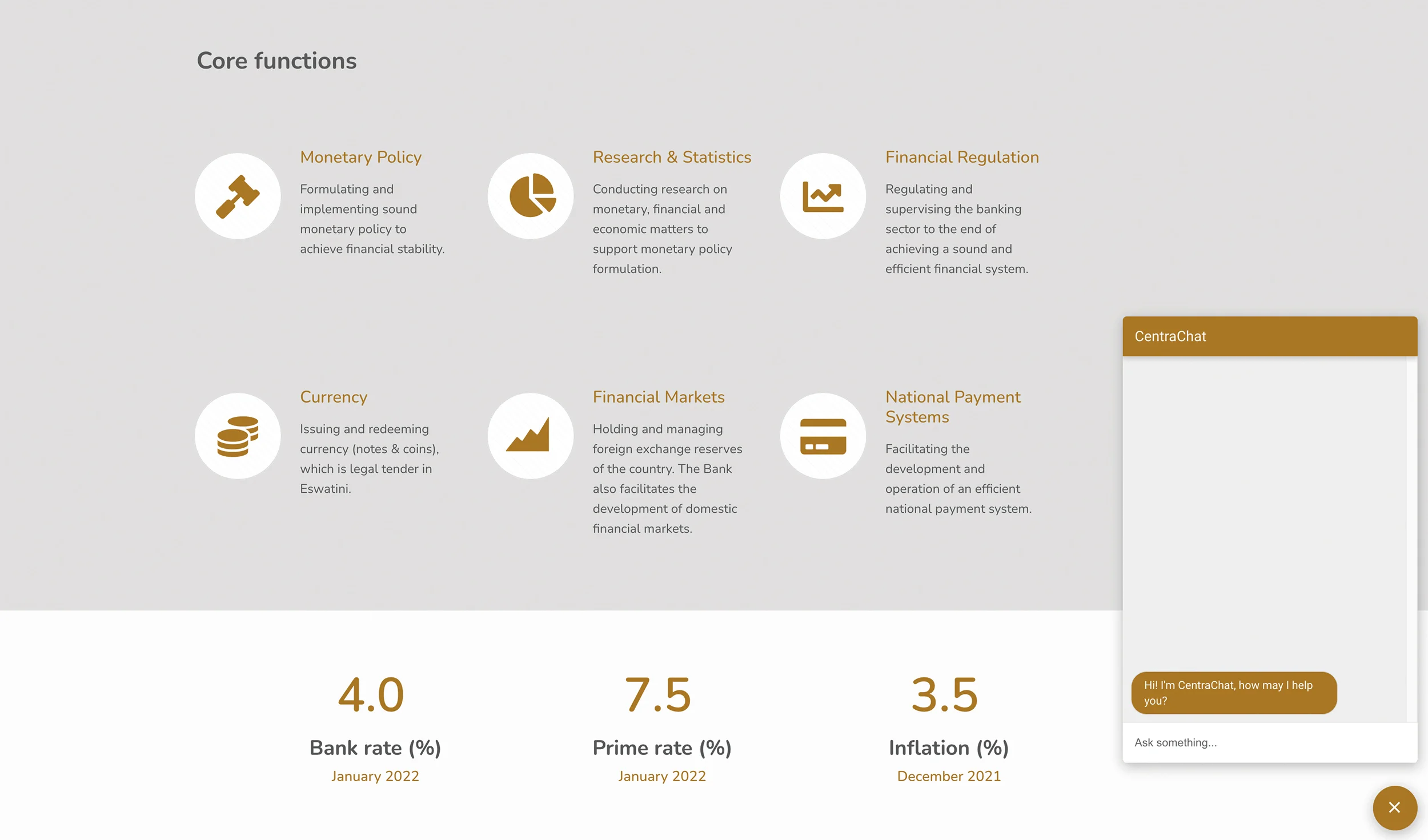
Website: Central Bank of Eswatini
The southern African central bank has made significant improvements to its website service

The Central Bank of Eswatini had plenty of work to do when it reviewed its outdated website at the end of 2020. Its internet offering was poorly optimised, lacking in security, and it provided little value for both the central bank and the people of Eswatini.
When the upgrade project began, a team at the central bank (which employs around 300 staff in total) created 16 objectives. The aim of the new site was to improve the user experience with easier navigation and a more modern feel. There was a requirement for the site to hold an SSL certificate, allowing it to move to the higher HTTPS encryption standard, plus the ability to incorporate data analytic capabilities and a chatbot.
The team used a customer journey map to outline the experiences for Eswatini’s population of just over 1 million people, as well as foreign parties that it expected to facilitate, from top to bottom in the new site. The aim was to significantly improve on the old website, which was unresponsive, with loading speeds not optimised by design, and was difficult to navigate. The new site would also have a cookie policy, and aim to improve back-end security.
There was also a serious need to improve searches. On the old website, if a member of the public searched for details on, say, credit schemes, they were diverted from the site to a Google search page, where they were in danger of not finding the information they needed – or worse, finding false information. The old website also had no capability to receive analytics, meaning the new site represented the first chance the central bank had to collect any insights about site visitors.
Another issue that needed to be addressed was that the old content management system failed to give administrators full rights to alter content. As a result, the services of an outside vendor were required every time the central bank needed to make small site amendments – changes that should have been part of standard administrator rights. The old system was costly in both time and resources.
Moreover, as elements such as press releases and large sections such as ‘Financial regulation’ automatically scrolled by in the old website’s design, they failed to move smoothly, as if there were loading difficulties in each small attempted movement.
New website
The new site, launched in April 2021, might not be as advanced as some other central bank websites, but it has transformed Eswatini’s ability to communicate with stakeholders.
“On the website’s welcome page, the lady in traditional regalia portraits our identity as Emaswati. The coins she is carrying represent the lilangeni currency, and the interactive vault door on the far right represents the storage,” Lwazi Dlamini, a communications and graphic designer at the Central Bank of Eswatini, tells Central Banking. “As you scroll down, the animation gives you the impression that you are opening a vault of information.”
Navigation has also been transformed. No information on the Central Bank of Eswatini’s website is more than three clicks away. Some information may come across as a little repetitive if one looks closely, but the central bank says it was designed that way to address the needs of an audience that wants to find information without searching too specifically.

There are five main branches of the upgraded website – ‘Home’, ‘Who we are’, ‘What we do’, ‘Publications’ and ‘Contact’ – with each linking to several sub-branches. The old site was far less structured.
The Central Bank of Eswatini started the project to develop the new website in early February 2021. In March, officials tested the site across different browsers, platforms and devices, including mobile phones, as well as its security and encryption standards. Then, in April, it went live. It took the Central Bank of Eswatini less than four months to radically improve its website. The team was able to receive SSL certification, create a chatbot and facilitate data analytic capabilities during this time.
This work was done in spite of staff shortages during the tail end of the second wave of Covid-19 to hit the country, with roughly 70% of the central bank’s staff working remotely. Once live, the new site played an important part in communication during the pandemic.
“Since they could not come to the office, our stakeholders were referred to the website to get information,” says Dlamini.
Audience analytics
Engagement with the Central Bank of Eswatini’s website has greatly increased in recent months. Unusually, a lot of the traffic is related to the high level of unemployment in the country, which stands at around 24%. The central bank publishes unemployment statistics on its Facebook page, which redirects additional traffic to its new website.
Exchange rates are the second most popular portion of the site. Reports on recent economic developments and statistics receive the next-largest portion of daily traffic. During the pandemic, individuals often viewed the website for information about the central bank’s small-scale loan guarantee scheme that helped keep small businesses liquid. Some citizens also come to the website for training. Eswatini’s central bank provides specialised training courses, which are advertised on its website. Courses teach such skills as financial technology, human resources, business and entrepreneurship.

According to its latest analytics report, the central bank’s site receives around 20,000 monthly page views and around 37,000 ‘page events’ to date – a page event is when a site visitor clicks, searches, scrolls or downloads something. Almost half of the traffic to the site is from Eswatini, with the US, South Africa, India, the UK, Germany and others representing increasingly small shares of the viewership.
The team is currently creating an interactive database for the website. This will display fully customisable data, such as (but not limited to) inflation figures from the central bank since 1974.
Eswatini’s central bank may not have the most sophisticated website in the world, or cover as many functions as some of its peers, but its April 2021 upgrade was a major step in providing improved information to the nation’s 1.2 million citizens.
The Central Banking Awards were written by Christopher Jeffery, Daniel Hinge, Dan Hardie, Victor Mendez-Barreira, Ben Margulies and Riley Steward
Only users who have a paid subscription or are part of a corporate subscription are able to print or copy content.
To access these options, along with all other subscription benefits, please contact info@centralbanking.com or view our subscription options here: subscriptions.centralbanking.com/subscribe
You are currently unable to print this content. Please contact info@centralbanking.com to find out more.
You are currently unable to copy this content. Please contact info@centralbanking.com to find out more.
Copyright Infopro Digital Limited. All rights reserved.
As outlined in our terms and conditions, https://www.infopro-digital.com/terms-and-conditions/subscriptions/ (point 2.4), printing is limited to a single copy.
If you would like to purchase additional rights please email info@centralbanking.com test test test
Copyright Infopro Digital Limited. All rights reserved.
You may share this content using our article tools. As outlined in our terms and conditions, https://www.infopro-digital.com/terms-and-conditions/subscriptions/ (clause 2.4), an Authorised User may only make one copy of the materials for their own personal use. You must also comply with the restrictions in clause 2.5.
If you would like to purchase additional rights please email info@centralbanking.com test test test




